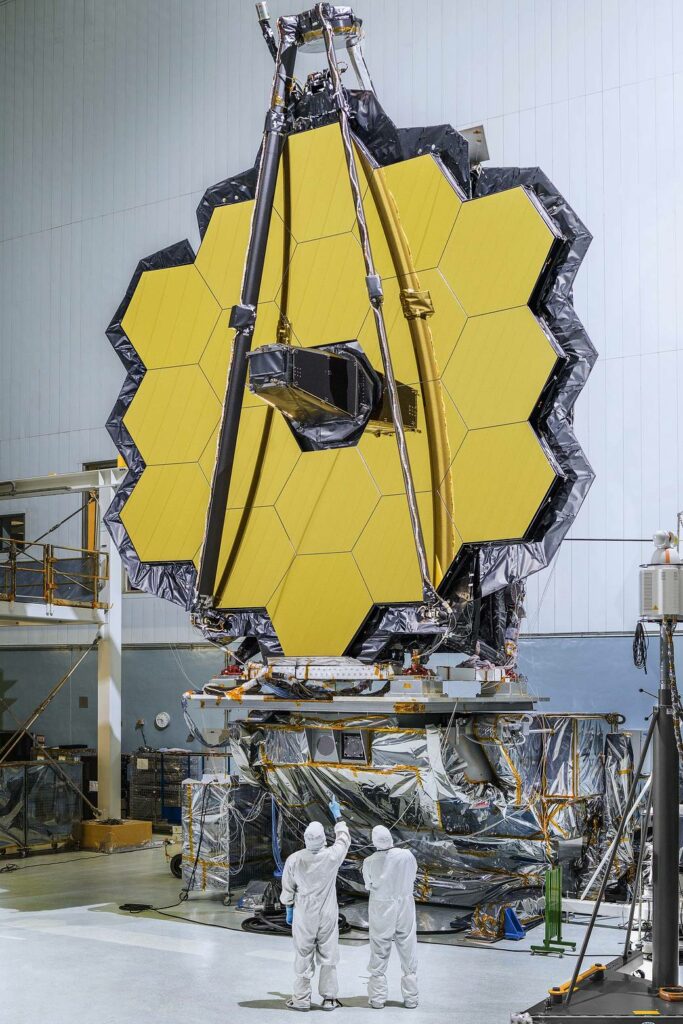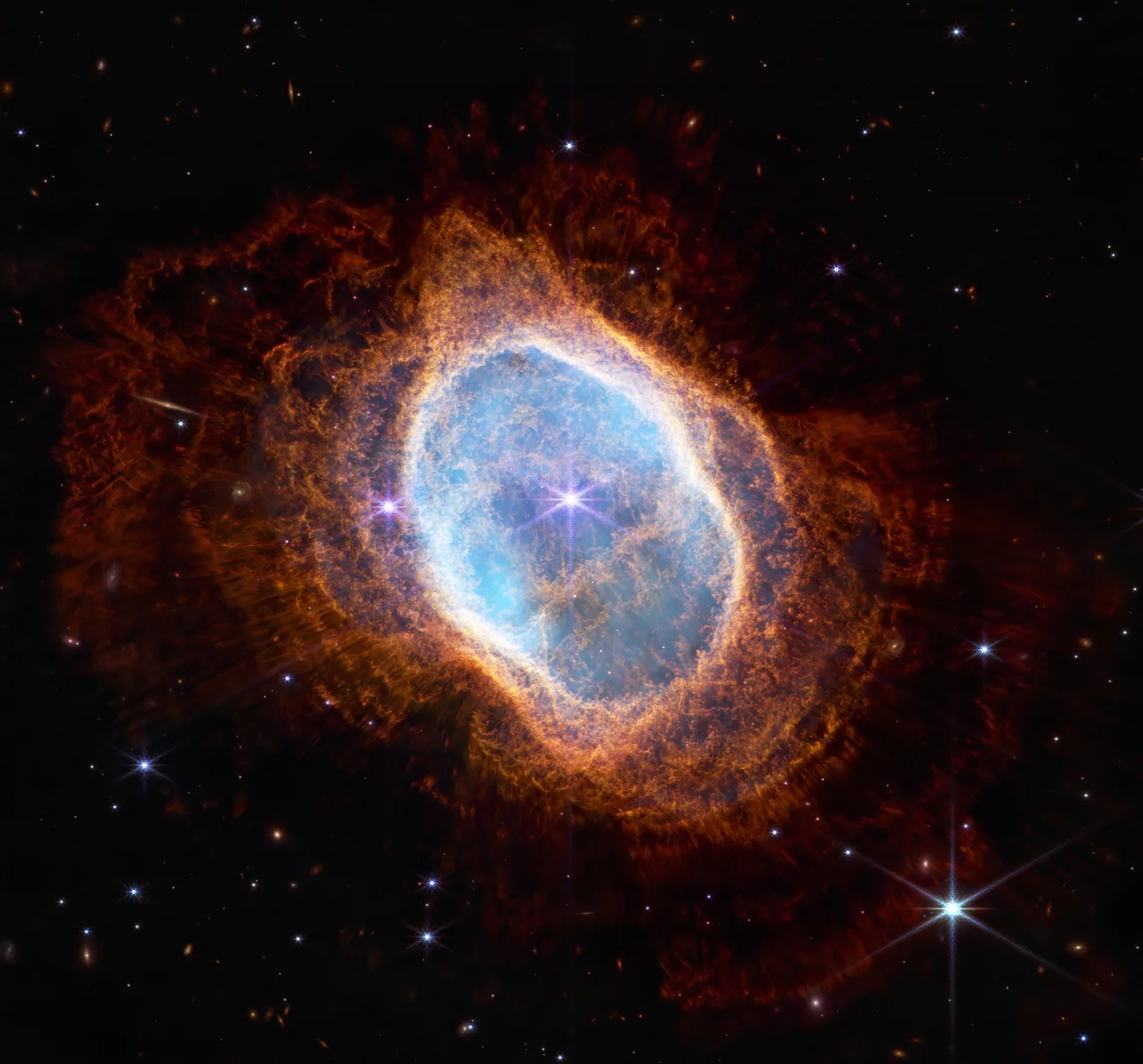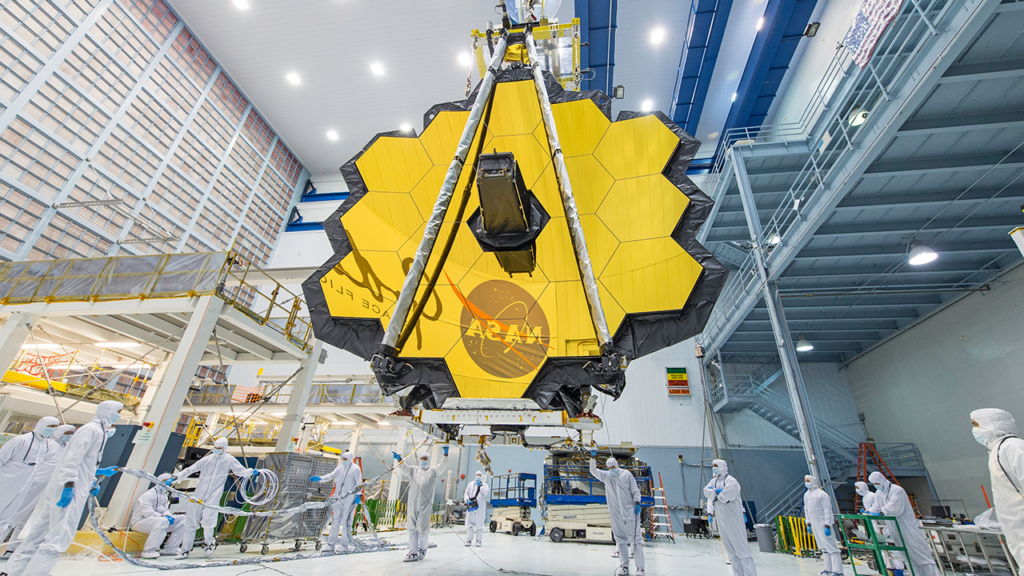Starting with the stunning release of JWST’s first image of galaxy cluster SMACS 0723 on July 11, the bonanza continued the morning of July 12 with newly released images of Stephan’s Quintet, the Carina Nebula, the Southern Ring Nebula, and exoplanet WASP-96b. Plus, that controversial name and what’s ahead for the newest space observatory.
Podcast
Show Notes
JWST images released July 11/12, 2022
- President Biden And The World Preview Webb Telescope’s First Image (NASA)
- NASA Reveals Webb Telescope’s First Images Of Unseen Universe (NASA)
- NASA’s Webb Delivers Deepest Infrared Image Of Universe Yet (NASA)
- NASA’s Webb Reveals Steamy Atmosphere Of Distant Planet In Detail (NASA)
- NASA’s Webb Captures Dying Star’s Final ‘Performance’ In Fine Detail (NASA)
- NASA’s Webb Sheds Light On Galaxy Evolution, Black Holes (NASA)
- NASA’s Webb Reveals Cosmic Cliffs, Glittering Landscape Of Star Birth (NASA)
Why we should rename JWST
- NASA Announces Contract For Next-Generation Space Telescope Named After Space Pioneer (NASA)
- Who is James Webb? (NASA)
- Clifford L. Norton, Appellant, v. John Macy et al. (Justia)
Transcript
The first fully processed images from the JWST have finally been released.
And we have them in all their glory along with scientific highlights, right here on the Daily Space.
I am your host Dr. Pamela Gay.
I am your host Erik Madaus.
And we’re here to put science in your brain.

After roughly a decade of delays, the JWST finally launched on Christmas day 2021. Almost 200 days later – 198 days later to be exact – the mission team released the first fully processed science images acquired by this giant telescope.
Made of 18 hexagonal mirrors, JWST’s primary mirror has a diameter of 6.5 meters, making it smaller than big-name scopes like Keck and Gemini but larger than anything previously put into orbit. That size is key to everything we’re going to see today.
An optical system’s resolution is directly related to the diameter of the light-collecting area and the color of the light being observed. The shorter – the bluer – the wavelength of light, the better you can see with a given telescope or eyeball.
For instance, Superman can resolve details 55 times smaller in his X-ray vision than in normal light because X-ray wavelengths are smaller. Since infrared light has longer wavelengths, we need larger telescopes to see details. We also need to put those telescopes above the Earth’s infrared-light blocking atmosphere.
These hidden colors of light have been studied by a long line of amazing space telescopes, with Spitzer being JWST’s scientific progenitor. Spitzer retired in January 2020 after sixteen years of service, and with its 0.85-meter mirror, we explored inside dust clouds and probed distant galaxies.
With its greater size, JWST will be able to see features roughly seven to eight times better than Spitzer in resolution and will be able to capture substantially fainter objects in what feels like the blink of an eye. This one-two punch of better resolution and greater light gathering power… the entire space science community has been waiting to see if that one-two punch packs the power needed to justify this mission’s ten billion dollar cost and decades-long delay. We can’t answer that question today, but we can show you what has been accomplished so far.
SMACS 0723

The first released image features galaxy cluster SMACS 0723, which was imaged by the Hubble Space Telescope as part of the RELICS project. This particular cluster is about four billion light-years away, depending on what cosmological parameters you use. In the grand scheme of our universe, that makes SMACS 0723 a relatively nearby galaxy cluster. Its mass of 840 trillion solar masses makes it a large cluster with the gravitational ability to bend light.
And the original Hubble image shows us a few streaks of light from distant galaxies getting gravitationally bent into view.
But with JWST, we see so much more.
And looking at this image, we see myriad little arcs and streaks. These are all extremely distant galaxies that have been magnified by gravity and distorted by the cluster to appear as arcs. These gravitationally lensed systems are most likely the most distant objects ever seen.
During the initial image release, NASA folks revealed that along with the image, JWST also took spectra that reveal that the chemistry of our modern universe was being created in these distant galaxies. We are literally looking at the birth of heavy elements.
This is just the first of five images. Things only get closer from here on out.
Stephan’s Quintet

I have to admit, for very silly reasons, Stephan’s Quintet is the image I was most looking forward to. In a 2005 Spitzer image of the five-galaxy field, two of the galaxies look distinctly like smiley faces, and really, the Universe needs more smiles.
See? Smiley face. This is that Spitzer image.
Stephan’s Quintet is named after its discoverer, French astronomer Edouard Stephan, who was cataloging the sky from Marseille Observatory in 1877. This field contains four interacting galaxies on their way to merging into a single giant galaxy, as well as a fifth interloper that is superimposed on the group.
The galaxies pop out in visual colors as shown in this image from the Canada-France-Hawaii Telescope, and when this visual image is combined with an X-ray image from Chandra, shown in blue, a mysterious arc appears. This arc can also be seen in radio and infrared images and is thought to be some kind of a shockwave, but this new image may be what is needed to figure out if that is exactly the case.
The arc is clearly visible in JWST’s infrared image, as are new and never before seen details. During NASA’s broadcast on these objects, they highlighted the topmost galaxy in this set. As it interacts with the other three gravitationally bound galaxies, its structure is getting disrupted. A tail of material is seen sweeping up and to the left, and in the infrared, knots of material can be seen jetting out of the galaxy’s core where an active black hole is feeding.
As these images are newly obtained and just released, we don’t have much by way of science results, yet, I can’t wait to see what new knowledge will be published in coming months.
Carina Nebula

Also released on July 12 was a new image of the Carina Nebula, also called NGC 3324. This nebula is located in the constellation Carina and is visible only in the southern hemisphere from the Earth’s surface. JWST, located at the Sun-Earth Lagrange 2, doesn’t have this problem.
NGC 3324 is an emission nebula — a cloud of bright gas shining from the high-energy photons coming from young stars. It is one of the biggest nebulae in the night sky. This is a stellar nursery – only a couple of million years old – where gravity makes the gas clump together until the clumps are dense enough to start nuclear fusion and become a star.
Prior to the image release, our team had to make a wild guess at what part of the Carina Nebula JWST would image, and we guessed wrong. I was hoping for the Eta Carina Homunculus or maybe the Defiant Finger or Mystic Mountain regions.
JWST actually imaged the Cosmic Cliffs region of the Carina Nebula. The browns and reds of the gasses are textured by the push of stellar winds and the pull of gravity. This cloud is collapsing and fragmenting with various knots of material breaking apart into clumps that will form stars and the stuff of solar systems.
We can expect that future studies of this system and the Orion star-forming region will allow us to detail out stellar nebulae at every stage of collapse.
Southern Ring Nebula

Next up, JWST takes a look at the Southern Ring Nebula, also known as the “Eight-Burst” nebula and cataloged as NGC 3132. Located about 2,000 light-years away, this nebula is a planetary nebula, but the name is a misnomer as no planets are involved in the formation of this particular object. Instead, the round shape, once mistaken to be a distant planet, is actually caused by huge shells of gas that were ejected from a dying star.
As seen in a classic Hubble image, NGC 3132 is about half a light-year in diameter, and the gas bubbles are expanding at a rate of fifteen kilometers per second with the binary system in the core just visible.
What appears as a smaller star to Hubble pops out as a brilliant red gem in the JWST image. This red star is the one responsible for the bubble. Eventually, the brighter star in the center will also reach the end of its life and eject a planetary nebula of its own, making the picture we see today much more complicated.
And the image we see from JWST is already really complicated. With its higher resolution, JWST reveals details in the structure of gas around the system that we had no idea were there. One of the justifications for Hubble was trying to understand planetary nebulae, and while it gave us greatly improved views, it didn’t solve the mystery behind their varied shapes. I, for one, look forward to this image being joined by a myriad of other nebulae that together can help us understand what is going on.
For now, though, NASA is just giving us five very different objects as it shows off JWST’s ability to see galaxies, stars, and even the atmospheres of planets.
Exoplanet WASP-96 b

Last but not least, we present WASP-96 b, an exoplanet located about 1,120 light-years away from our solar system in the direction of the Phoenix constellation. This hot Jupiter is about half the mass of our own Jupiter and orbits its parent star every 3.4 days. The atmosphere seems to be free of clouds and contains sodium.
Of course, this particular target is not on the list for the stunning image that could be taken but for the incredible spectrum that was collected. We’ve all been anticipating just what JWST could do with the atmosphere of an exoplanet, and now we have our first scientific result.
WASP-96 b orbits a star like our own but is very close in and was considered an ideal candidate for the JWST’s first spectra because of its size, relatively low density, and that potentially cloudless atmosphere. JWST observed the planet during a transit back in late June and collected data for almost seven hours. This data then was used to generate a light curve and a spectrum. The light curve didn’t tell us anything we didn’t already know, but it did provide more detail. The spectrum, however, reveals that WASP-96 b’s atmosphere has water, haze, and actual clouds, which is a brand new discovery.
One of the new capabilities of the JWST is the ability to take spectra on multiple different objects simultaneously. The transmission spectrum of WASP-96 b was created from 280 individual spectra.
And with a bigger telescope, more detail is what we want.
One quarter of JWST’s first year of observations will be of exoplanets, both their surfaces and atmospheres. These include the TRAPPIST-1 system, which has the largest batch of possibly habitable exoplanets found to date, and two sub-Neptune gas giants, GJ 1214 b and TOI-421 b.
We definitely are looking forward to all of that wonderful exoplanetary atmosphere research.
Why We Should Rename JWST

We’re all super excited about the JWST’s potential. Today’s image release makes it clear that this scope does work. But our excitement is tempered by knowing that this telescope isn’t without controversy: specifically, we need to address the elephant in the room – its name.
There are a couple of reasons why the name isn’t the best, independent of what James Webb did during his time at the State Department and at NASA, though both of those issues are very significant.
First, the usual process for naming a telescope is to give it a utilitarian name during building and launch and only bestow a formal name after launch, commissioning, and a return of good data. The name is decided by a committee of different NASA centers. That process was not followed with the JWST. In 2002, then NASA Administrator Sean O’Keefe unilaterally decided the Next Generation Space Telescope would be renamed JWST without input from the scientific community at large.
Like O’Keefe, Webb was a government bureaucrat and not a scientist or engineer. While bureaucrats are needed to keep nations going, they are not who we normally name missions after. Space telescopes are generally named after scientists who pioneered the areas of research that the telescope will advance: such as Edwin Hubble, Enrico Fermi, Neil Swift, and others.
So, broken procedure and a break from tradition. Today, it is becoming common to name telescopes before their launch, such as the Nancy Grace Roman Telescope, and we dread the day that will one day come when an already named telescope fails to function and some brilliant researcher’s name is forever tied to a defunct moment in history.
Webb is also a name that reminds many researchers of a time in our past that is painful.
Back in the 1950s and 1960s, Webb was complicit in an event known as the Lavender Scare. Just as the Red Scare was led by propaganda from then-Senator Joe McCarthy and persecuted American Communists – both real and perceived – the Lavendar Scare aimed at a different group of people – the LGBTQ community. Through a similar process of moral persecution and identification, possible members of the LGBTQ community were harassed, questioned, and even fired. However, when the astronomy community began to push back on the questionable naming of the new telescope, NASA’s response, to say the least, was lackluster.

NASA’s own acting chief historian, Brian Odom, along with an unnamed external historian, had difficulty accessing archives due to the COVID-19 lockdown. Working with what they could, they determined that there was no evidence to support the allegations that Webb was involved in an organizational policy that persecuted and fired LGBTQ employees at NASA. So NASA announced that would not be renaming the telescope. Not only did NASA not present their findings to the public when they made their announcement, reporters and scientists had to file Freedom of Information requests to see what was actually discovered.
And in the midst of all that research was the story of Clifford Norton, who was accused, questioned, and fired from NASA for being homosexual. He pushed back and sued the agency, winning an appeals court ruling that he was wrongfully dismissed. Within that ruling, the chief judge noted that the person who fired Norton had asked if it was possible to keep him on since he was a “good employee” but that the personnel office had said it was “custom within the agency” to fire suspected homosexuals.
A documentary on James Webb and his potential role in the Lavendar Scare has been released by The JustSpace Alliance. We’ll link to it in our show notes, and we strongly encourage you to watch this well-researched show. We will have a review of the documentary in a later episode.
And we will have more science from more telescopes in later episodes, but today is JWST day.
This has been the Daily Space.
You can find more information on all our stories, including images, at DailySpace.org. As always, we’re here thanks to the donations of people like you. If you like our content, please consider joining our Patreon at Patreon.com/CosmoQuestX.
Credits
Written by Pamela Gay, Beth Johnson, Erik Madaus, and Gordon Dewis
Hosted by Pamela Gay, Beth Johnson, and Erik Madaus
Audio and Video Editing by Ally Pelphrey
Content Editing by Beth Johnson
Intro and Outro music by Kevin MacLeod, https://incompetech.com/music/


 We record most shows live, on Twitch. Follow us today to get alerts when we go live.
We record most shows live, on Twitch. Follow us today to get alerts when we go live.